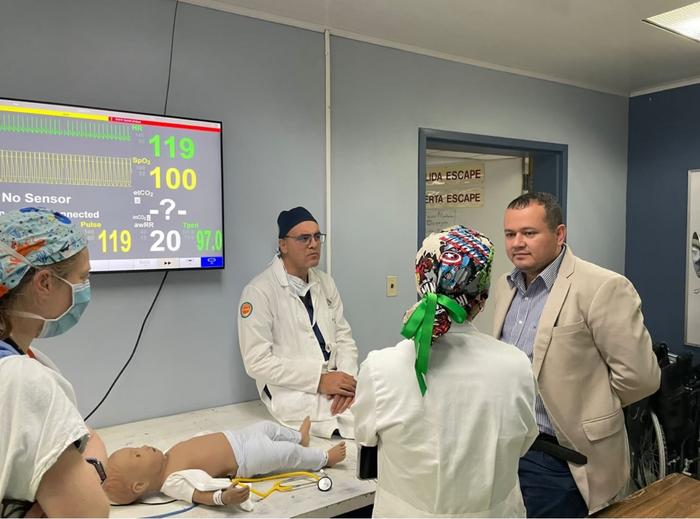Pediatric intensive care units (PICUs) in low and middle-income countries see elevated mortality rates, often 10 times higher than those in high-income countries. One leading risk factor is the high incidence of unplanned intubation — a procedure that inserts a tube into the child’s airway — which can lead to complications like hypoxia and ventilator-associated pneumonia. Interventions that improve clinical practices can help reduce child mortality in countries with limited resources.

Credit: Careways Collaborative
Pediatric intensive care units (PICUs) in low and middle-income countries see elevated mortality rates, often 10 times higher than those in high-income countries. One leading risk factor is the high incidence of unplanned intubation — a procedure that inserts a tube into the child’s airway — which can lead to complications like hypoxia and ventilator-associated pneumonia. Interventions that improve clinical practices can help reduce child mortality in countries with limited resources.
In a new study published June 12th in Frontiers of Public Health, investigators from Mass General Brigham demonstrated reduced mortality in intubated pediatric patients after the implementation of a low-cost quality improvement (QI) program in the largest public children’s hospital in El Salvador. Mortality rates in the PICU dropped from more than 22 percent to 9.5 percent in the year after the educational intervention was introduced. These results build on previous work by the same group that utilized educational videos translated with voiceovers in Spanish by employing AI tools, aimed at improving knowledge of local care teams and optimizing the safe care of intubated patients in the PICU.
“We believe these changes indicate a burgeoning PICU safety culture stemming from the QI framework the local clinical team had previously learned,” said first author Phoebe Yager, MD, chief of the Division of Pediatric Critical Care Medicine at Mass General for Children. “They expanded their practices to include daily reviews of non-airway factors such as nutrition and reconfigure the space to allow for better ventilation and easier access for the nurses to provide care.”
After collecting pre-intervention data over an 18-month period on factors like demographics, illness severity scores and mortality, the researchers deployed QI and educational interventions including the AI-generated Spanish-language video tutorials on how to correctly intubate and monitor patients. They also developed a Driver Map and Impact Pathway models, which were data-driven diagrams that factored in the local environment and provided customized targets for interventional strategies. The team then gathered post-intervention data over three months each for two cohorts separated by a 36-month interruption due to the COVID-19 pandemic.
Analysis of the final dataset of nearly 150 patients revealed a significant drop in PICU unexpected intubations in addition to a sustained decline in mortality. Further, the authors also observed the use of several new quality practices developed by the local PICU care team following the initial QI intervention.
“These new initiatives from the local team indicate that the observed sustained improvements in pediatric patient care is multifactorial and complex, and speak to our intervention’s triggering a focus on quality improvement measures and a cascade of subsequent QI activity ,” said senior author Christopher Hartnick, MD, chief of the Division of Pediatric Otolaryngology at Mass Eye and Ear. “This study serves a model for global health care to develop quality improvement programs to allow children to go safely from home to hospital, and to home again, expanding on current programs focusing only on the operating room.”
The authors believe their Driver Map and Impact Pathway models can be a paradigm used throughout global healthcare to identify components for effective QI interventions in low- and middle-resourced countries. Future studies can advance this work to cultivate replicable and sustainable programs that extend to operating rooms, wards, and every facet of a child’s journey from home to hospital and back home again.
Authorship: Mass General Brigham authors included Yager, Hartnick, and Kevin M. Callans, RN. Additional co-authors included Aubrey Samost-Williams , Jose A. Bonilla , Luis J. G. Flores , Susana C. A. Hasbun, Angel E. A. Rodríguez, Alejandra B. A. Cárdenas, Alexia M. L. Núñez , and Asitha D. L. Jayawardena.
Disclosures: The authors declare no conflicts of interest. Hartnick and Yager are co-founders of CareWays Collaborative, a nonprofit global health mission organization affiliated with Mass Eye and Ear and Massachusetts General Hospital.
Funding: The authors declare no financial support for the research.
Paper cited: Yager, P, et al. “Practical quality improvement changes for a low-resourced pediatric unit” Frontiers in Public Health DOI: 10.3389/fpubh.2024.1411681
About Mass General Brigham
Mass General Brigham is an integrated academic health care system, uniting great minds to solve the hardest problems in medicine for our communities and the world. Mass General Brigham connects a full continuum of care across a system of academic medical centers, community and specialty hospitals, a health insurance plan, physician networks, community health centers, home care, and long-term care services. Mass General Brigham is a nonprofit organization committed to patient care, research, teaching, and service to the community. In addition, Mass General Brigham is one of the nation’s leading biomedical research organizations with several Harvard Medical School teaching hospitals. For more information, please visit massgeneralbrigham.org.
Journal
Frontiers in Public Health
DOI
10.3389/fpubh.2024.1411681
Method of Research
Experimental study
Subject of Research
People
Article Title
Frontiers in Public Health 01 frontiersin.org Practical quality improvement changes for a low-resourced pediatric unit
Article Publication Date
12-Jun-2024
COI Statement
The authors declare no conflicts of interest. Hartnick and Yager are co-founders of CareWays Collaborative, a nonprofit global health mission organization affiliated with Mass Eye and Ear and Massachusetts General Hospital.




